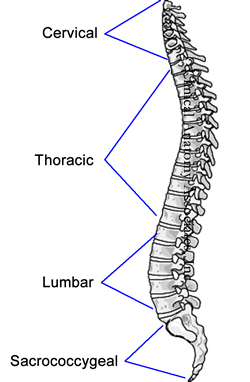UPDATED: In both these words the suffix [-osis] means "condition". The root term [-kyph-] is Greek and means "bent or bowed" without an indication of the direction of bending, thus the term was originally used for any abnormal spinal curvature. It was Hippocrates who first used this term to denote "hunchback". Since then the term [kyphosis] denotes a curvature of the spine towards posterior, or better described, a spinal curvature in the median plane with a posterior convexity.
Hippocrated also used the Greek term [lordosis] to denote a curvature opposite to kyphosis. Lordosis is then a spinal curvature in the median plane with an posterior concavity.
In the human spine, as viewed from the lateral aspect (see image), there are four normal curvatures. The cervical and lumbar curvatures are lordotic, while the thoracic and sacrococcygeal curvatures are kyphotic. Based on this description kyphosis and lordosis are normal conditions of the human spine.
A pathological, excessive, or exacerbated curvature should be denoted with the terms [hyperkyphosis] and [hyperlordosis] respectively; the prefix [hyper-] meaning "excessive". Through use, the terms [kyphosis] and [lordosis] are also used to denote pathological conditions. Hyperkyphosis has mostly a thoracic presentation, while hyperlordosis has mostly a lumbar presentation.
In vernacular terms, an individual with hyperkyphosis is known as a "hunchback", while an individual with hyperlordosis is known as a "swayback".
Image property of: CAA.Inc. Artist:D.M. Klein




